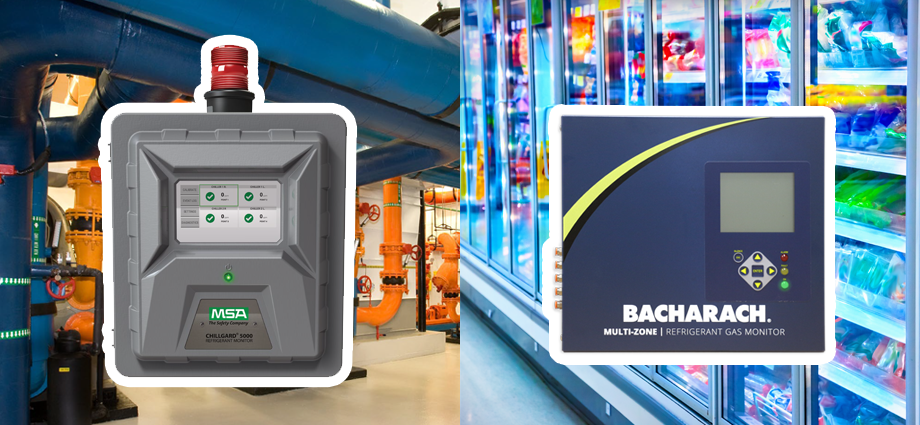
A large regional US food retail chain, with over 400 stores, strived to reduce refrigerant emissions across their sites as part of their environmental emissions reduction program. With an industry average refrigerant leak rate of 20-25%, the food retail chain wanted to drive their emissions down below 10% to meet their refrigerant compliance objectives. They needed a comprehensive, connected solution that paired best-in-class low-level refrigerant leak detection equipment with an effective IoT enabled remote monitoring platform for greater visibility and enhanced notification. MSA provided a complete turnkey hardware and software connected solution, enabling low-level detection, 24/7 remote monitoring and support, and portable leak detectors with pin-point accuracy for rapid repairs.
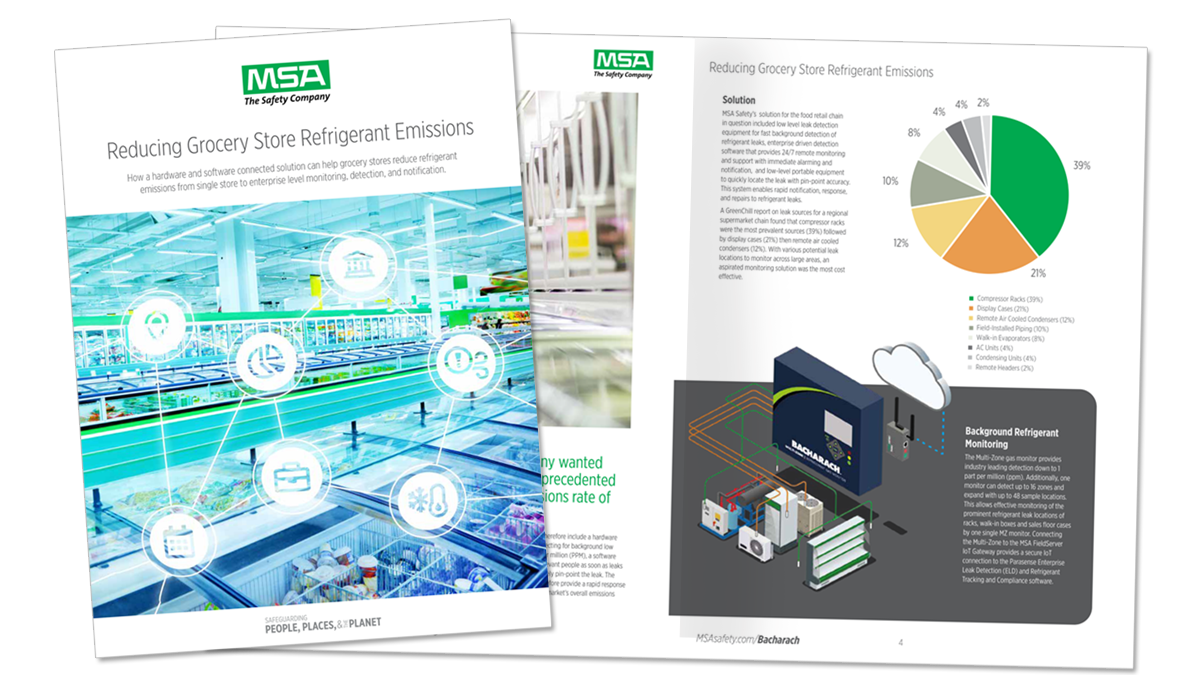
Download your copy of this success story and find out how MSA Safety’s Connected Solutions experts can help you reduce your refrigerant emissions.
Download the PDFFood Retailers are taking customer demands and corporate social responsibility seriously and aligning to achieve net zero refrigerant emissions targets within the next 20 years. To achieve this, a close examination of the whole operation is needed, such as finding better cold chain solutions that require more efficient transportation and lower energy consumption. However, supermarkets must also consider the hidden carbon equivalent of refrigerant emissions, especially for high Global Warming Potential (GWP) refrigerants and HFCs.
The average supermarket system contains thousands of pounds of refrigerant, and depending on the refrigeration system used, leaks an average of 20-25% of its refrigerant each year. The North American Sustainable Refrigeration Council (NASRC) state, this adds up to “70 Million metric tons of CO2 equivalent emissions each year just from supermarket refrigeration leaks. That is equivalent to the emissions from powering 12 million homes, which is roughly the number of households in the state of California”.
MSA provided a complete turnkey hardware and software connected solution, enabling low-level detection, 24/7 remote monitoring and support, and portable leak detectors with pin-point accuracy for rapid repairs.
Beyond environmental costs, there are significant financial costs associated with refrigerant emissions too. Lost refrigerant needs replaced once the leak has been fixed – and with spiraling refrigerant costs due to the AIM Act phase down, as well as supply chain constraints, this is a constant challenge. What’s more, when refrigerant charges are below the optimum level, the equipment requires more electricity to maintain operations – adding extra financial cost and CO2e emissions. Additional financial costs of spoilage, lost sales, and customer dissatisfaction occur as well.
To tackle the refrigerant emissions issue for supermarkets, the United States Environmental Protection Agency developed a Corporate Emissions Reduction Program for food retailers; GreenChill. The voluntary partnership program works cooperatively with food retailers to help:
- Transition to environmentally friendlier refrigerants
- Lower refrigerant charge sizes
- Eliminate refrigerant leaks
- Implement best environmental practices
- Adopt green refrigeration technologies
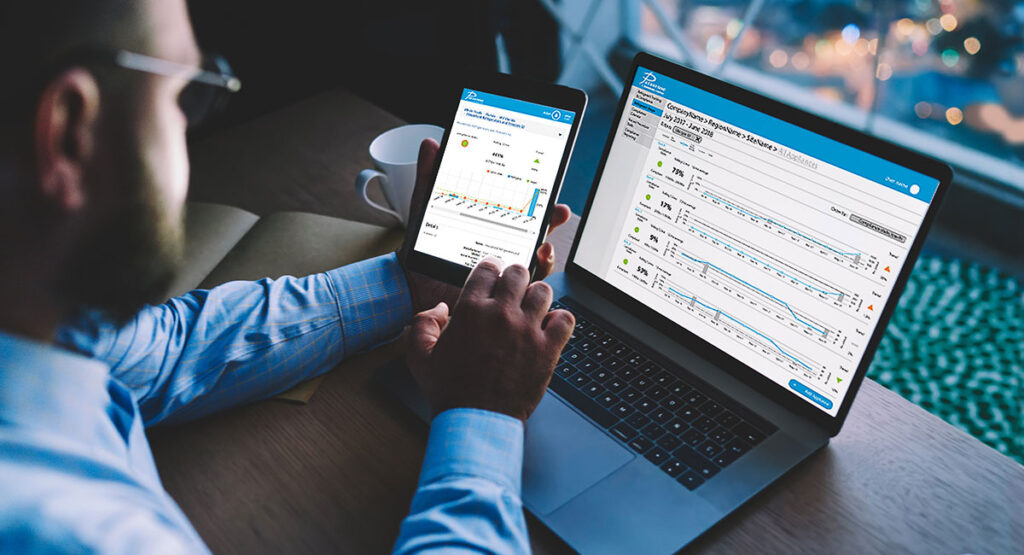
Concern
As with most Supermarkets in the United States, intent on reducing refrigerant emissions to meet GreenChill certification objectives, the company wanted to achieve an unprecedented refrigerant emissions rate of less than 10%. For GreenChill, a food retail store can achieve Platinum, Gold, or Silver level certification. Each category calls for more stringent requirements that must be met. For example, Silver level store certification requires:
- Only non-ozone depleting refrigerants used
- Refrigerant must be accepted by the EPA’s SNAP program for food retail use
- Achieve an average HFC refrigerant charge of no more than 1.75 pounds per 1,000 BTUH load
- Store-wide annual HFC refrigerant emissions rate of 15% or less
The Supermarket’s requirement must therefore include a hardware solution capable of monitoring and detecting for background low level refrigerant leaks below 10 parts per million (PPM), a software solution that can immediately notify relevant people as soon as leaks are found, and a fast solution to effectively pin-point the leak. The complete, connected solution must therefore provide a rapid response to refrigerant leaks to support the supermarket’s overall emissions reduction targets.
Solution
MSA Safety’s solution for the food retail chain in question included low level leak detection equipment for fast background detection of refrigerant leaks, enterprise driven detection software that provides 24/7 remote monitoring and support with immediate alarming and notification, and low-level portable equipment to quickly locate the leak with pin-point accuracy. This system enables rapid notification, response, and repairs to refrigerant leaks.
A GreenChill report on leak sources for a regional supermarket chain found that compressor racks were the most prevalent sources (39%) followed by display cases (21%) then remote air cooled condensers (12%). With various potential leak locations to monitor across large areas, an aspirated monitoring solution was the most cost effective.
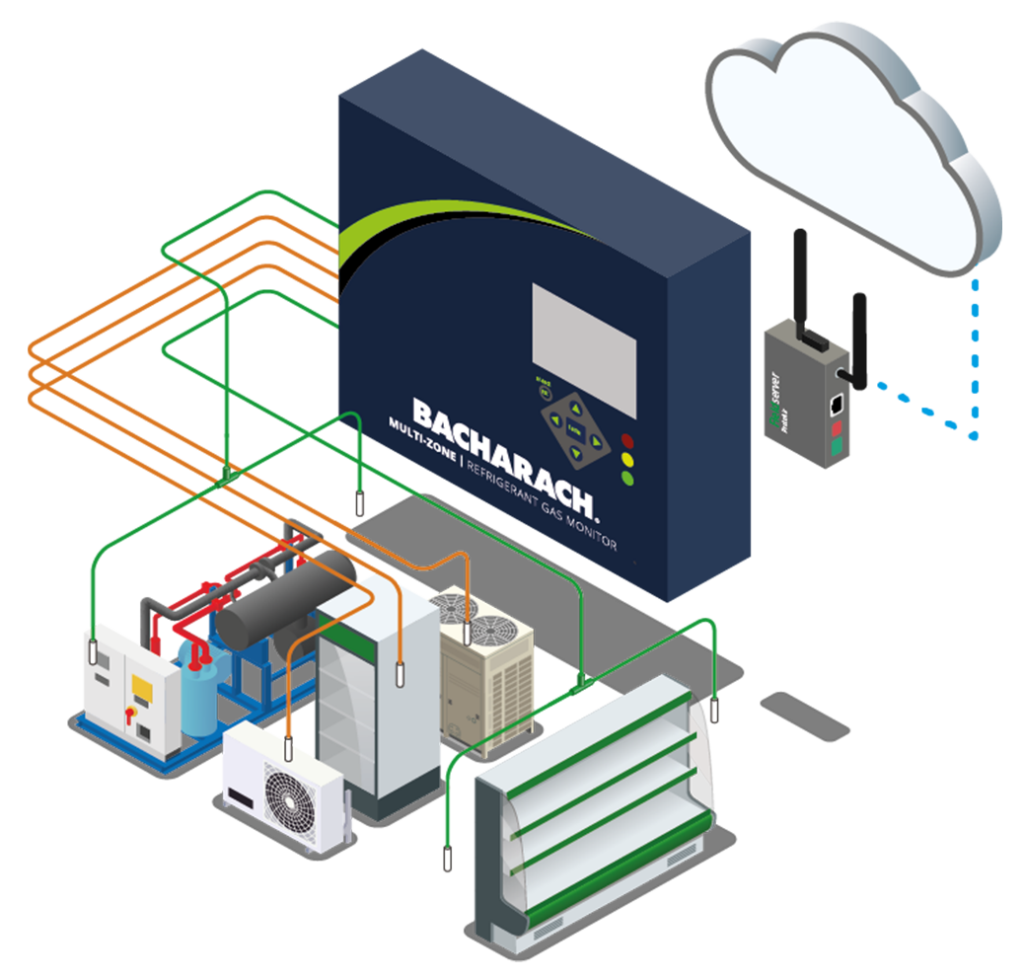
Background Refrigerant Monitoring
The Multi-Zone gas monitor provides industry leading detection down to 1 part per million (ppm). Additionally, one monitor can detect up to 16 zones and expand with up to 48 sample locations. This allows effective monitoring of the prominent refrigerant leak locations of racks, walk-in boxes and sales floor cases by one single MZ monitor. Connecting the Multi-Zone to the MSA FieldServer IoT Gateway provides a secure IoT connection to the Parasense Enterprise Leak Detection (ELD) and Refrigerant Tracking and Compliance software.
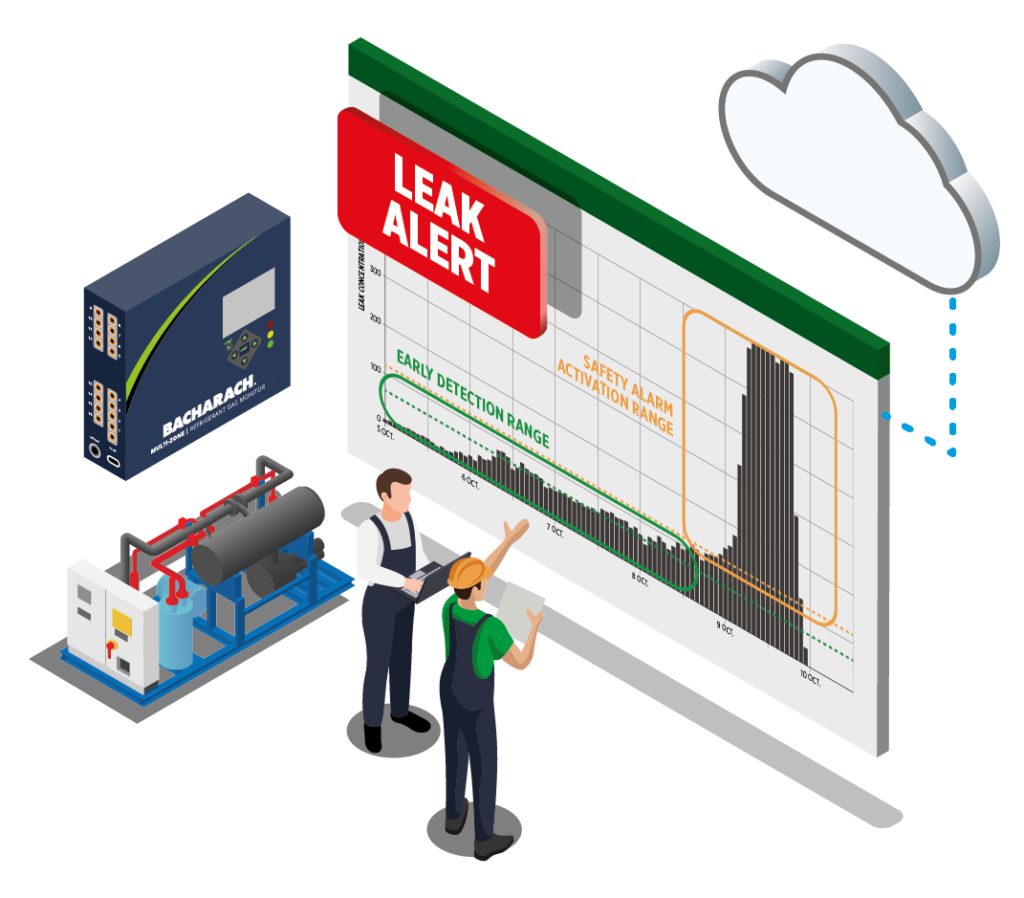
Enterprise Notification & Rapid Response
The complete Parasense enterprise connected solution provides live event monitoring of the entire store portfolio in real-time. This means that should a refrigerant leak be detected within the monitored store, and for all the other stores in the chain, the enterprise software notifies the relevant teams immediately.
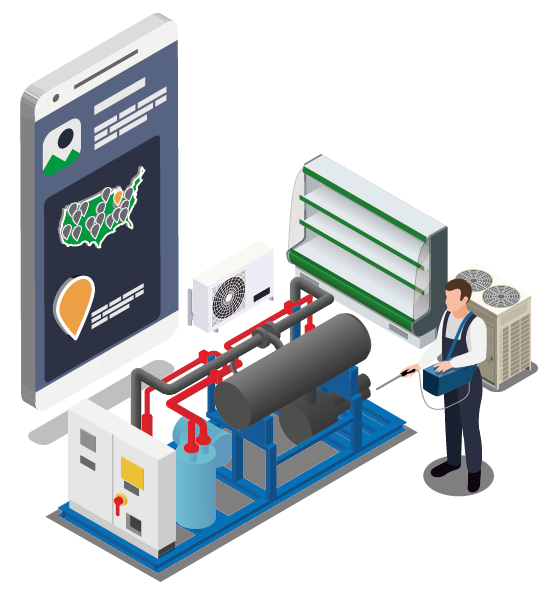
On-Site Low Level Portable Leak Detection
The complete Parasense enterprise connected When a leak is found within the store, it’s important to accurately pin-point and fix the leak as quickly as possible, minimizing downtime and potential hazards. This is where the portable Bacharach® PGM-IR, with the same industry leading infrared sensing technology as the Multi-Zone, can find leaks fast down to 1PPM.
Application
The Connected Solution provided by MSA Safety was put to the test at approximately 1:00 PM on October 25, 2021. Despite the foot traffic and subsequent airflow within the store, the Multi-Zone monitor began to detect refrigerant at the supermarket’s dairy refrigerated counter. Although the leak started small, the Multi-Zone’s technology was able to detect it at an early stage of development.
As the leak increased in intensity, the development was automatically tracked by the Parasense cloud-based ELD software. Once the alarm stage was triggered, the Parasense Connected Solution automatically engaged the nearest refrigeration contractor to rectify the leak.
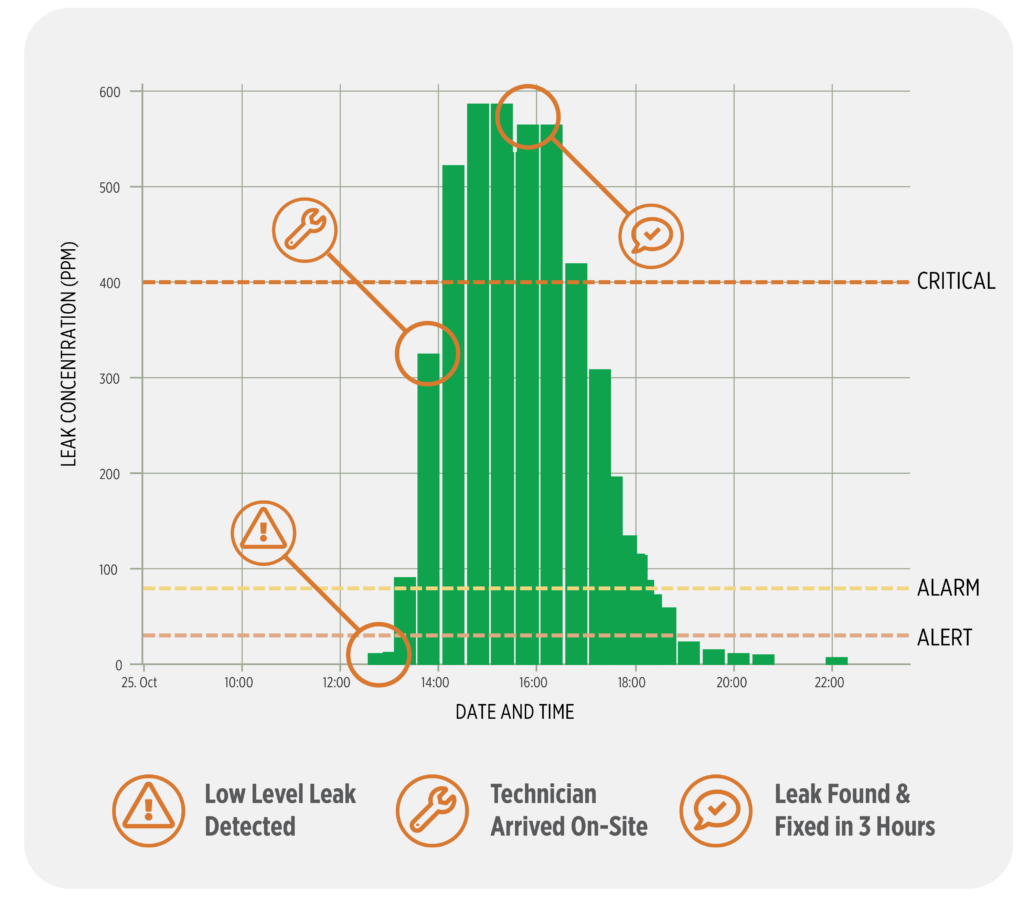
With detailed analysis of the leak location and intensity before the contractor was on-site, the Parasense rapid response team was able to triangulate the leak’s location across the different sample points in the store. When the contractor arrived, the team directed the contractor to the refrigeration equipment. With the PGM-IR, the leak was then accurately pin-pointed and ready for repair.
Within just three hours, the refrigerant leak had been identified, located, and fixed. A perfect testament to the robust Bacharach® refrigerant detection equipment and the Parasense Connected Solutions refrigerant management suite. The store managed to keep downtime to a minimum and were delighted in how their refrigerant emissions reduction had been greatly reduced.
Conclusion
Through dedication to exceptional refrigeration management of the retail food store chain, and the implementation of MSA’s best-in-class connected refrigerant leak system, the retailer has achieved GreenChill certification and won several awards over the years. With average grocery store refrigerant leak rates around 20-25%, this chain exceeded all expectations after bringing its corporate leak rate down to 7%. Beyond the cost savings and positive return on investment, their commitment to operational sustainability helped safeguard people, places, and the planet. Reach out to MSA’s team of Gas Detection Experts to learn more about choosing the right system to achieve corporate emissions goals.



